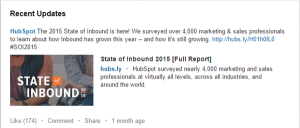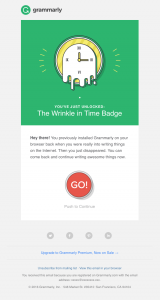App store optimization (ASO) is about getting your mobile app in front of the right users at the right time.
With 2.22 million apps available in the Apple App Store and 2.89 million in the Google Play Store, you need the best possible strategy to help your app stand out.
In this post, we’re sharing how ASO helps you increase traffic and downloads, the specific on-metadata vs. off-metadata factors that matter, and how to leverage ASO mechanics to maximize conversions.
How to leverage app store optimization (ASO) to improve app visibility, conversion rates, and retention
ASO is about improving your app’s visibility to drive awareness, conversions, and prolonged engagement.
Like with SEO, there are rules you need to follow (to satisfy algorithms), best practices (depending on your goals and audience), and consistent testing and optimization.
Done right, ASO can reduce user acquisition costs, increase app downloads, and improve your app’s value.
But ASO, like search engine optimization, fails when worshipped like a false god. Installs and conversions should be celebrated, but 21% of users abandon apps after one use and the average 30-day post-install retention rate is only 5.7% (industry-wide). We can’t rely on install metrics alone to substantiate success.
A positive and engaging experience to improve retention is just as important as downloads or conversions (if not more). Otherwise, you’ll live in an inflated metrics loop that doesn’t reflect true, long-term value.
Building a sustainable customer experience that goes beyond conversion rates is key.
Stand out from the crowd with brand differentiation
Everyone wants their app to stand out, but you can’t differentiate on features alone. Increased competition leads to commoditization, and your ideas will get copied.
Banking apps used to show your bank balance on the go. Now, customers expect to be able to make transfers between accounts, pay other people, and alert their banks to fraud. Mobile banking has become tablestakes, and the same cycle will repeat when the next unique feature comes into play.
To stand out, you need a strong user experience (more on this below) and brand differentiation. ASO helps you avoid sameness by:
- Becoming more discoverable for relevant keywords that users search for. 70% of Apple App Store visitors use app store search to discover apps. And, 65% of downloads happen post-search. Sounds promising, but don’t use keywords to cast a wide net. You’ll end up chasing false-positive click-to-install metrics that don’t improve conversion rate optimization. Instead, conduct voice-of-customer research to align your keywords with audience intent and capture quality downloads that won’t immediately churn.
- Lowering your customer acquisition costs (CAC). The average app install cost per Facebook Ad in 2020 was $ 3.50. Paid ads can supplement organic reach, but should not drive your ASO strategy. 90% of worldwide app installs are organic, so play the long game to boost retention, not the short game to capture misaligned downloads. To keep CAC low, leverage earned media, build influencer partnerships, prioritize your UX, measure post-install events to reengage users, and consistently optimize on-metadata and off-metadata app store factors (more on this in the next section).
- Ensuring users stick around longer. The best ASO strategies take into account that app value drives user engagement and retention. Understanding your target audience and how they interact with your app allows you to enhance targeting initiatives. Doing so helps to level up your UX and build personalized, tailored journeys. Most importantly, your app needs to improve users’ quality of life (QOL) so they’re incentivized to use it every day.
Let’s unpack that last thread in more detail.
Prioritize user experience to build an app that improves quality of life
To build a valuable app that incentivizes daily use, you need to understand your audience. Go beyond the basic standard indicators (demographics, jobs, salaries, location, etc.).
To understand QOL, you need to uncover how your audience perceives the world:
- What makes them feel like they belong?
- Is feeling safe a priority? If so, why, and how do they measure security?
- Do they prioritize mental and physical health to achieve wellbeing?
- What is the most frustrating part of their day, and why?
- What helps them wind down after a long day?
- What hobbies do they lean on to pass the time or fulfill a passion?
The answers to these questions will help you build, promote, and optimize an app that becomes integral to users’ daily lives. Approximately 70% of users churn by day 30 because UX doesn’t prioritize or speak to QOL inflection points.
If your UX doesn’t solve or align with a foundational problem, need, or desire, users will move on. If your ASO strategy prioritizes awareness and discoverability, you’ll continuously see high downloads and high churn. A better approach is to optimize for value and focus on long-term retention.
To do that, you need to define goals pre-launch to drive optimization post-launch.
Define goals with continuous growth in mind
Improving daily wellbeing is a worthy mission but it’s not easily measurable. To understand if you’re delivering on QOL, tie it to tangible metrics.
Start by determining which in-app events are the most valuable. If improving wellbeing is a mission, ‘daily meditations completed’ might be a worthy event to track.
Define SMART goals (Specific, Measurable, Achievable, Relevant, and Time-Bound) to ensure they are measurable, realistic, aligned with your audience, and tied to a timeframe.
This way, you know what in-app events are relevant to your audience (and why), if you’re hitting your goals, and what tweaks are needed to improve the experience.
Take Headspace. Their app is free to download, but the goal is to get users to subscribe for $ 12.99/month to unlock premium content.
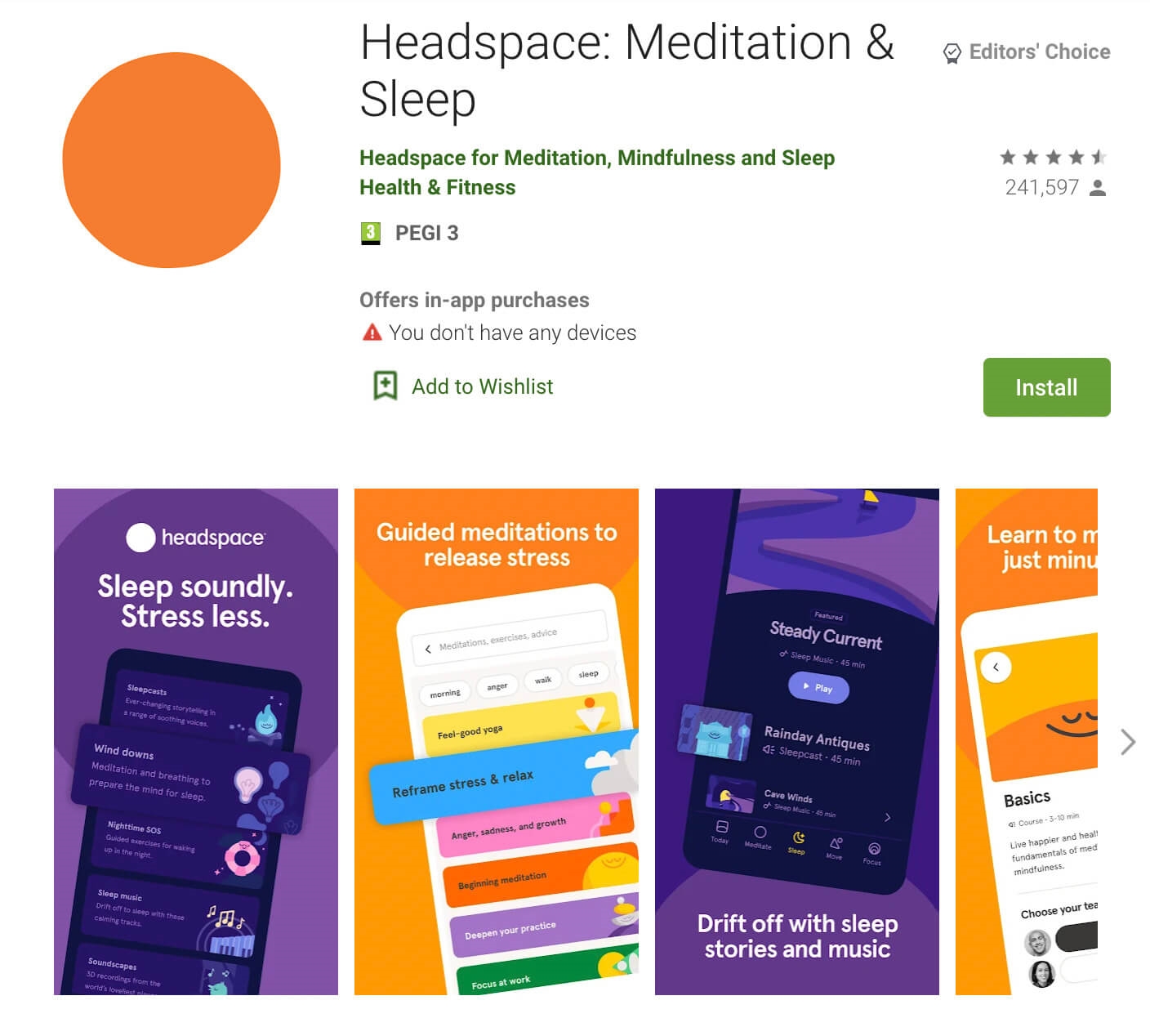
Goals to measure could be “X users completed free trial in X timeframe” or “X users completed basics course in X timeframe”.
With data in hand, they can segment which of those users completed the course but did not go on to use the app again. Then, target them with user acquisition campaigns.
That could be paid ads, incentivizing existing users to leave positive reviews or to share their experience on social media to elicit social proof.
This way, ASO is tied to tangible metrics rooted in app value with engagement and retention top of mind.
The mechanics of ASO and how to leverage them to maximize conversions
Understanding the technical factors behind ASO will help you leverage them to improve your strategy and maximize app value.
On-metadata vs. off-metadata factors
Like technical SEO, on-page and off-page optimization carry equal weight.
A mix of broken links, slow site speed, low-quality content, and a confusing UI can contribute to poor website growth. Both behind-the-scenes and customer-facing attributes affect reach and engagement.
The same rings true for ASO. Meeting technical requirements and satisfying the user journey will impact your position and growth.
On-metadata and off-metadata factors contribute to driving awareness, traffic, installs, user acquisition (UA), and user retention.
Critical on-page elements include:
- App title and subtitle
- Description
- Keywords (iOS apps only)
- Icon
- Screenshots/Videos
- App updates
Off-metadata includes:
- App install volume
- Ratings/User reviews
- App usage and engagement
- Uninstall rate
Let’s look at how to use and leverage each one to boost performance.
Optimizing on-metadata elements and building your app brand
On-page elements are mostly in your team’s control.
1. App title and subtitle
The most important factor is the app title. It should be memorable, on-brand, descriptive, and include your target keyword.
Your title is the first thing people see. It explains what your app does, which helps potential users understand if the app is a good fit for their needs. Users are more likely to recall distinctive names, according to a cognitive bias we all have called the distinctiveness effect.
As with SEO titles, there are optimum length guidelines. App titles should be under 30 characters for iOS apps and under 50 characters for Google.
Shazam’s app title tells you exactly what it does: “Shazam: Discover songs & lyrics in seconds”:
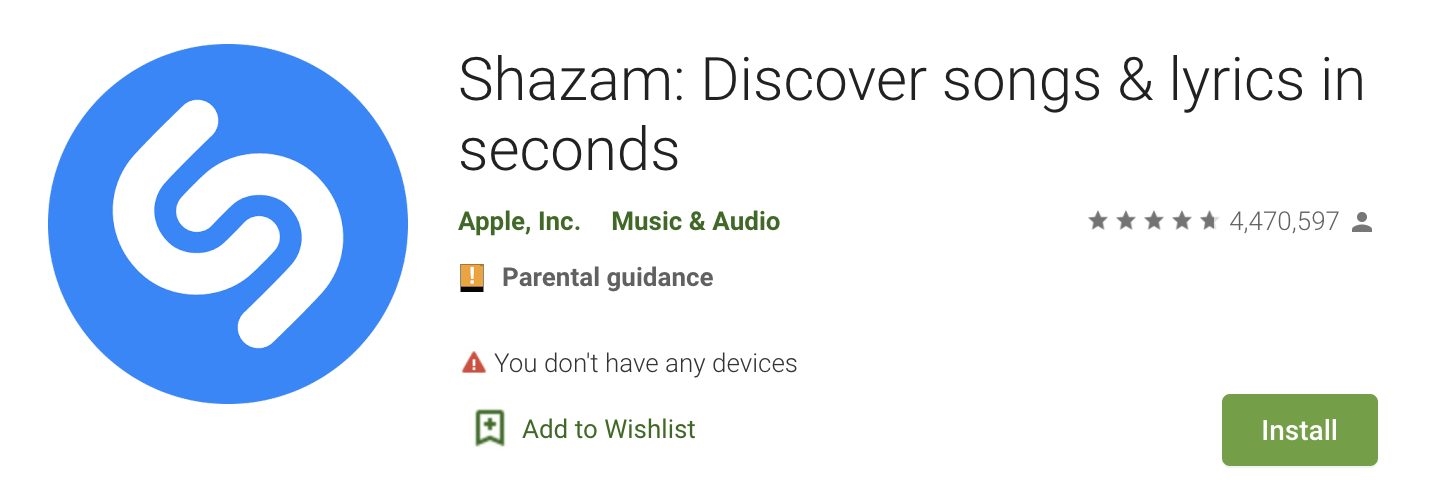
It’s memorable because it has a unique app name and a benefit-driven explanation (“in seconds”).
Optimizing your app title for memorability and succinct description increases the likelihood the right users will install it.
The subtitle is also important but only applies to the Apple App Store. Shazam’s Apple App Store listing varies slightly from Google Play because of the extra 30 characters worth of space:

They convey the USP “Discover songs & lyrics in seconds” in two lines rather than one. Same message, slightly tweaked.
2. Description
Google Play pulls keywords from the description. Keywords for Apple apps come mainly from a separate keyword field, which we’ll cover momentarily.
Every marketer knows keyword stuffing deteriorates readability. If that isn’t warning enough both Apple and Google explicitly caution against this in their guidelines.
Take Habit Tracker’s app description introduction. They’ve sacrificed delivering useful information above the fold for keywords in an attempt to manipulate app store search rankings:
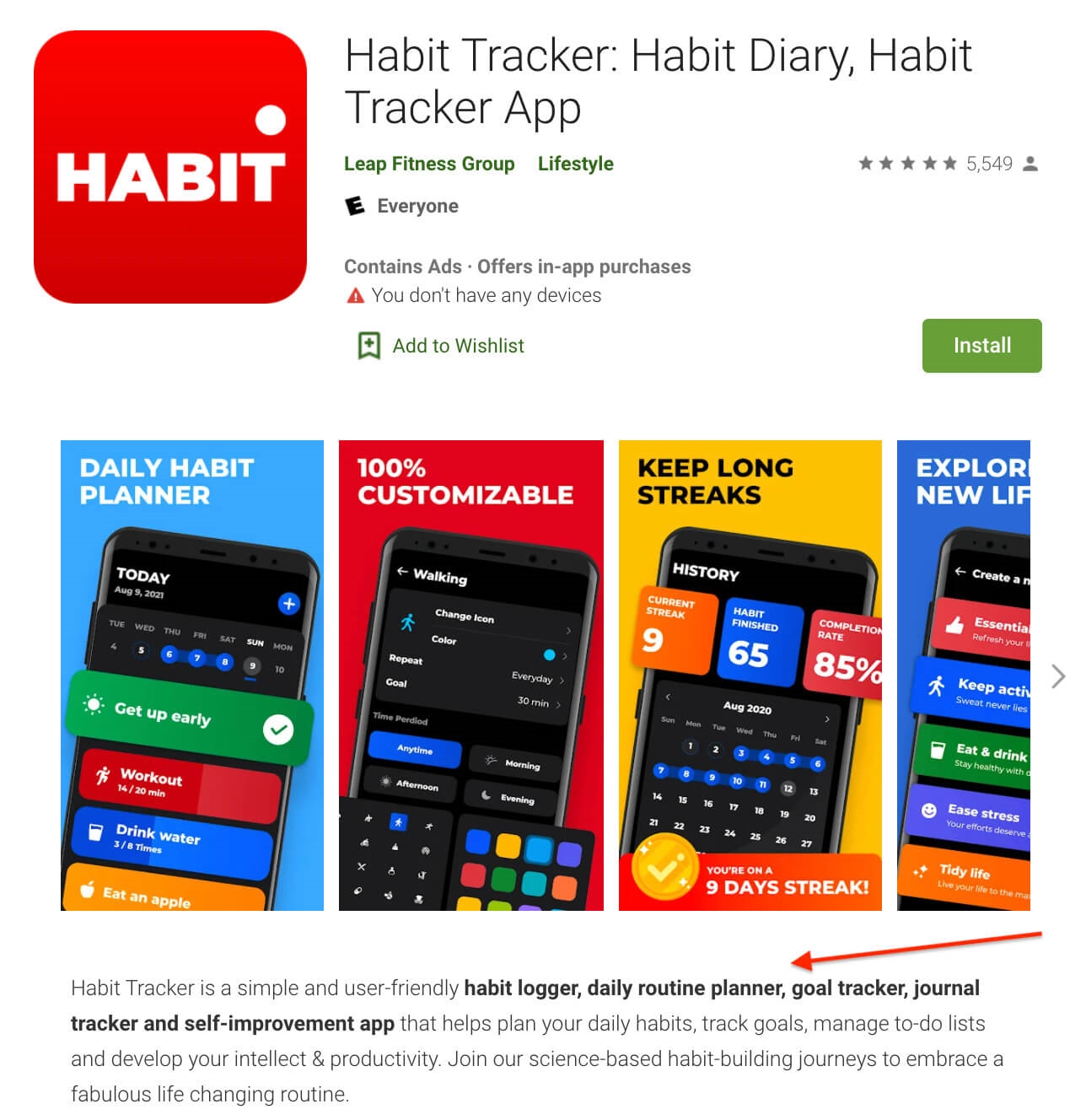
Compare this with the top result for “habit tracker” when searching the Google Play Store. Loop Habit Tracker’s description introduction is clear and benefit-driven:
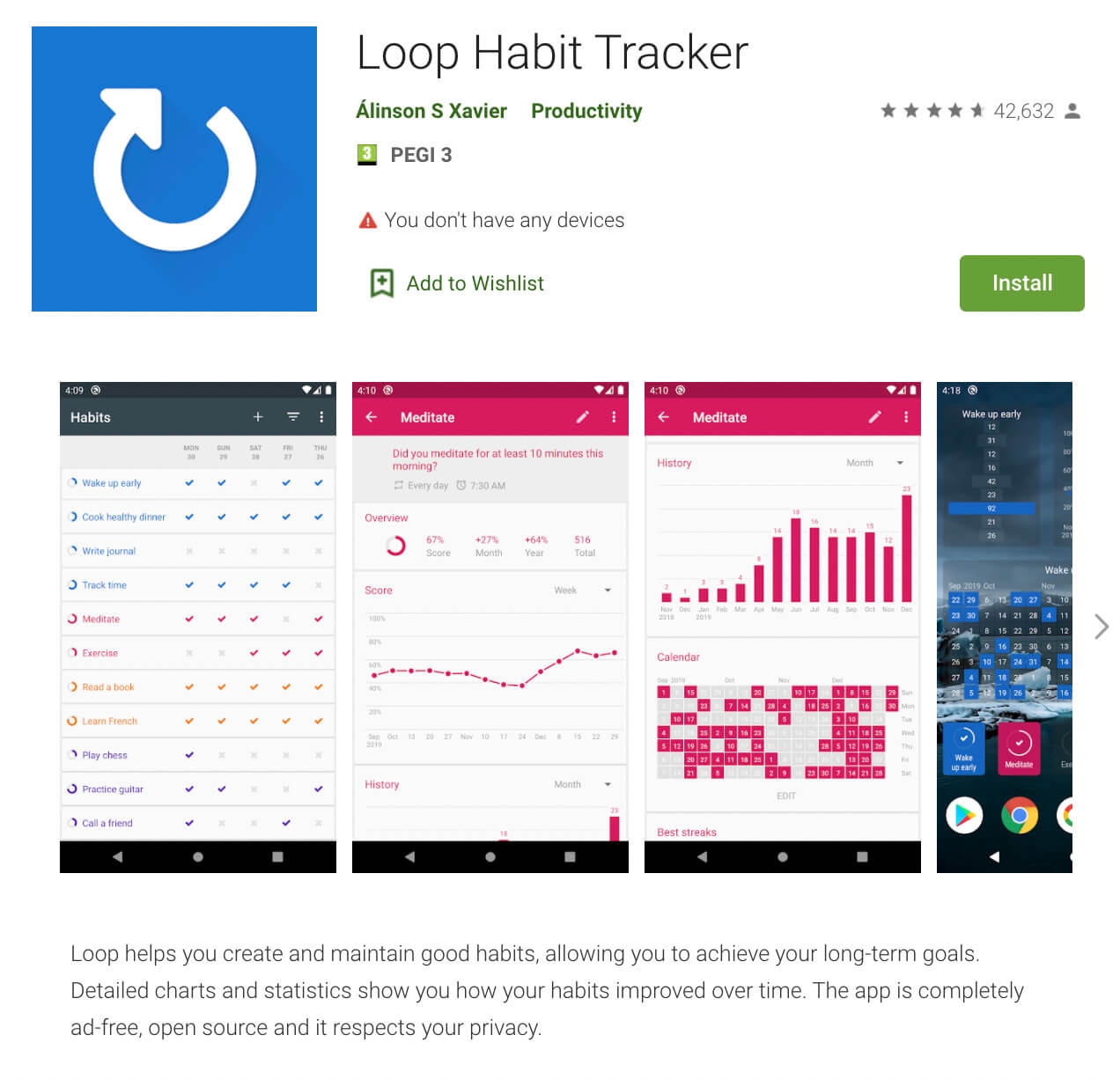
Not to mention it dominates Habit Tracker in installs (1,000,000+ vs. 100,000+) and ratings (5,440 vs. 42,632).
Of course, these metrics could boil down to a stronger all-around strategy, but the description differences (and keyword optimization) do weigh in.
One speaks directly to the target audience in their language, is compelling, and clearly describes benefits that align with pain points and goals. The other does not convey a unique value proposition (UVP) and misses an opportunity to connect with the audience.
3. Keywords (iOS only)
While the Google Play Store pulls keywords from the description, Apple pulls keywords from the keyword section which is hidden to users.
These keywords should complement your app’s title, what the app does, and the user intent. Here are some tips for choosing the right keywords:
- Research competitor keywords. Seeing what your competitors rank for gives you a head start. You can learn (and apply) what is and isn’t working for competing apps.
- Use app store optimization tools for keyword research. AppRadar, AppAnnie, Keywordtool.io, and AppTweak give you deeper insights into who is using your app and how they are discovering it. App analytics can help you with goals like targeting higher-value users, lowering CAC, and reducing ad spend.
- Focus on app keywords that have the right intent. A common mistake is to focus too much attention on app keyword traffic and not enough on relevance and intent. Targeting a keyword with less search volume but higher intent and relevance might mean less traffic, but higher-value users. Improved ratios of conversions and retention will mean more visibility in the Apple App Store.
4. Icons & Screenshots
A key component of consistent brand messaging is the screenshots you choose. A good first impression can increase conversions by 35%, according to a report by Storemaven.
Treat app store screenshots like imagery on your landing page. Relevant, eye-catching visuals add to your UVP, capture attention, and help tell a story.
App store images play a pivotal role in whether a user decides to learn more and ultimately download the app. Consider:
- Are the app’s icon and screenshots consistent with your brand’s style guidelines?
- Do your app screenshots describe what your app does?
- Can a user see how they’ll get value from the app within three seconds of viewing the screenshots?
- Do the screenshots look consistent with the design of the app’s landing page?
Take Duolingo’s app product page.
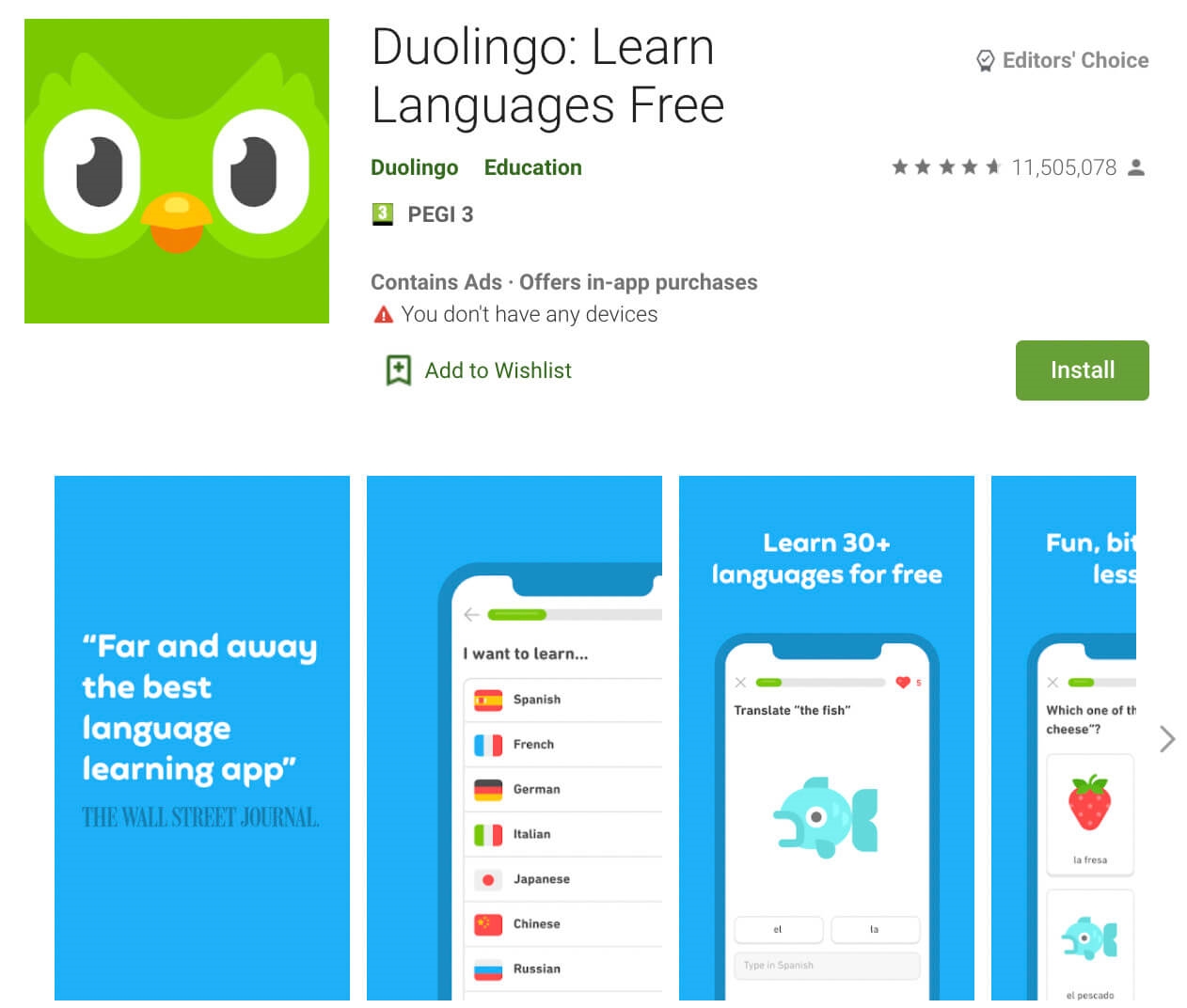
Within three seconds of viewing the Duolingo screenshots, you know the following:
- It’s the best free language learning app (their UVP)
- They have serious street credibility with a review in The Wall Street Journal
- You can learn more than 30 different languages
- They make learning a new language fun (i.e. the playful owl mascot in their app icon)
Another brand that gets this right is Pinterest. Within a few seconds of viewing their screenshots, they’ve convinced you that Pinterest is useful whenever you are looking for inspiration.
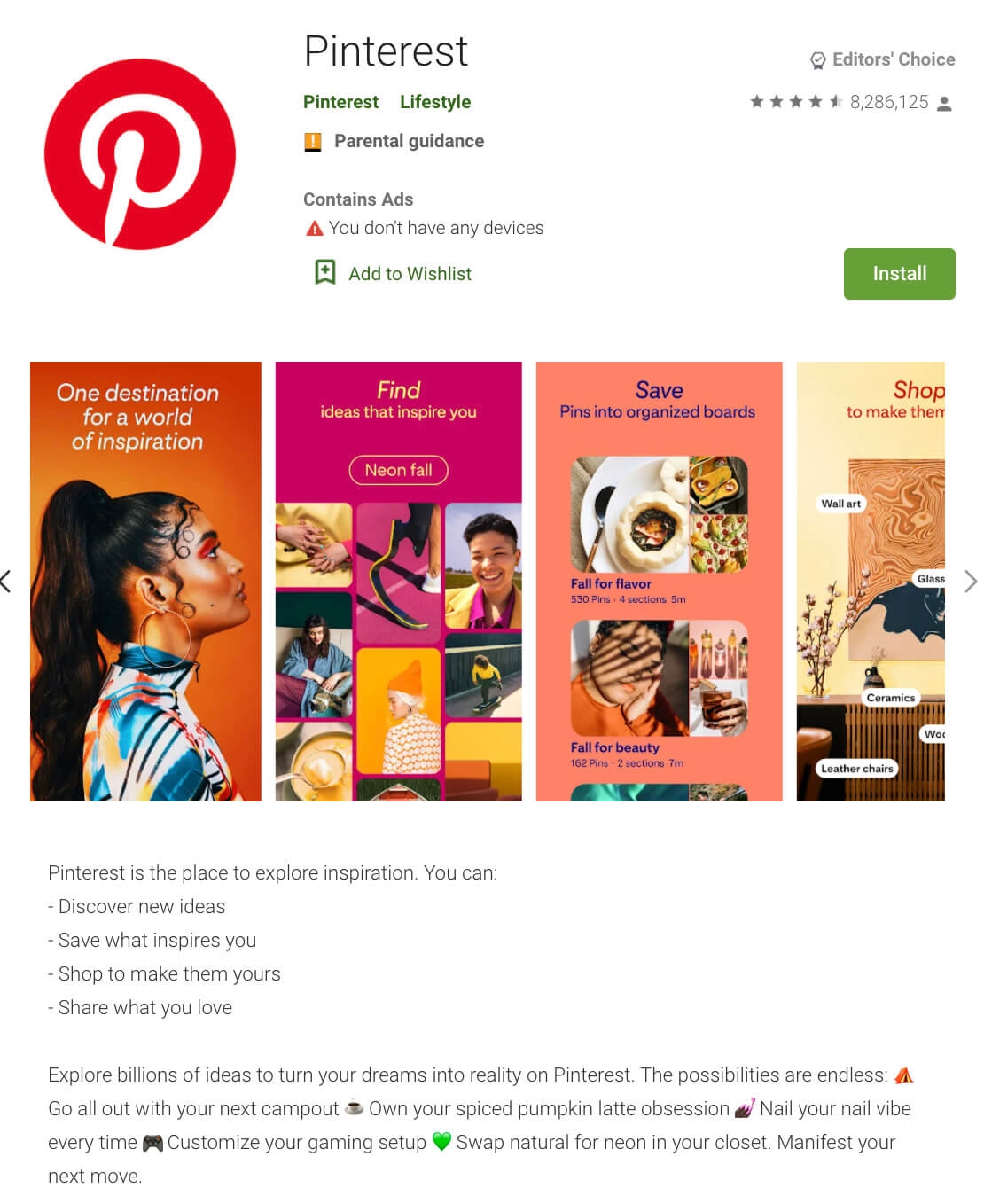
You can use Pinterest to:
- Find new ideas
- Save and organize them (to revisit later) in pins and boards
- Shop within the platform
- Share your ideas with friends, family, and colleagues
They also reinforce their core USP by sharing the main ways their users leverage Pinterest to get inspired.
However, ideal screenshots for iOS may not compute in the Play Store. As they cater to different audiences with unique mindsets, each app store should be considered as a separate channel.
Not to mention, each store comes with different rules for creatives. You can only upload up to 8 screenshots on the Google Play store. On the Apple App Store, you can upload up to 10 screenshots.
5. App Updates
An often-overlooked on-page factor is app updates. No one wants to download an app that was built once and then abandoned.
Consistently releasing new app updates (and patching errors or security issues) can help increase your authority, improve UX, and establish credibility with app users. Bugs are common, so don’t hide them. And releasing new features and versions are table stakes in the world of technology, so don’t fall behind.
Clearly tell your users what you fixed or released so they can get excited about enhanced functionality and features. But don’t robotically publish fixes in developer speak. Here is another opportunity to speak in your audience’s language like a human, not a robot.
Slack does this well:

Their updates are short and conversational and approachable. Users can see what’s been improved without navigating through complex language.
They also release new updates weekly, so users know they can expect this app to continuously improve.
Slack’s regular update policy also shows customers they are listening and applying feedback, which works to increase loyalty and build trust.
Optimizing off-metadata elements by attracting and retaining users
You have more control over off-metadata elements than you might think through savvy A/B testing and optimization strategies.
1. App downloads
The number of app downloads you have indicates popularity, and the app stores take this into account when ranking.
As mentioned above, even though app downloads affect app store ranking and awareness, don’t prioritize number of downloads above value. This will lead to high downloads, high churn, and poor retention.
Still, awareness is a key part of getting your app in front of your target audience. Apple takes into account install velocity, daily growth, and first-time installs when ranking.
Google also considers high velocity and first-time installs as a ranking factor.
The best way to improve downloads is to focus on building an app that improves QOL and communicating install-to-value through a strong brand messaging strategy, social proof, and data-driven optimization.
2. App usage & engagement
As we discussed previously, the real metric that app developers should focus on is installs-to-value.
Ask questions like:
- What percentage of people downloading the app are using it?
- How long does it take for a user to get to the “aha” moment, where the value of the app becomes apparent?
- How long are they spending in the app?
- How often are they coming back to the app? Are they using it daily, a few times a week, weekly, etc.?
The way to drive app usage and engagement is with a strong onboarding strategy. User activation is critical to answer initial questions and tailor the experience.
Tie onboarding to a business goal so you can monitor it and optimize the process.
Let’s stick with Pinterest as an example:
- The first action a new Pinterest user needs to take is to create an account. So, your in-app goal is the number of users who create an account successfully.
- Then, they need to create a board and pin one item. Your metric is the number of new users who create a board and pin at least one item.
- You can then nudge them to get their first follower by encouraging them to share their first pin or board with a friend. Your primary metric here might be the number of new users who have at least one Pinterest follower.
Map out specific interactions that help new users get more value from your app quickly, so they stick around.
As you get more new users, you can use cohort analysis to study the data from a previous new user cohort. You can also discover which in-app events you should be nudging users toward by analyzing the most engaged users.
3. Ratings/User reviews
App ratings and user reviews are akin to testimonials and social proof. They signal to potential high-quality leads that your app is worth its weight in gold, and should be added to a daily use rotation.
Positive reviews send a signal to Apple and Google that people value what you’ve delivered. They’ll then use this data to inform their ranking strategy.
You should also mine reviews to understand what’s working well and what’s not. Applying the feedback to fix bug issues or develop new features can improve UX and help you climb the ranks.
The most effective way to get more reviews is to ask for them. Follow Pinterest’s lead and ask for reviews in-app updates:

You can also send push notifications at completed milestones asking for reviews. If a user reaches X followers or completes a course track, you can send an in-app notification asking for a review while the achievement is top of mind.
Since 50% of users disable push notifications, you can also target app users on Google, Facebook, or Instagram to ask for an app review at a certain point after install.
Conclusion
App store optimization is an ongoing process. You can’t do a little keyword research, write an app description, publish a few screenshots, and forget about it.
If you want to drive lasting results, you need to build and execute your ASO strategy. This starts with understanding your users, focusing on their experience, and tracking and optimizing your on-metadata and off-metadata.
Business & Finance Articles on Business 2 Community
(44)



